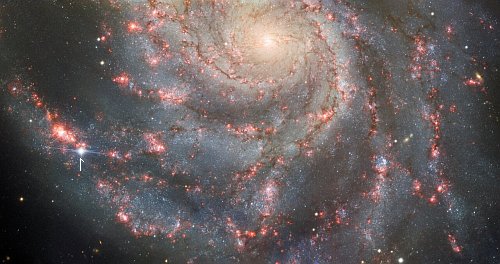Nearest supernova in a decade confirms such stars lose mass prior to exploding

Arrow points to supernova. Click for original image,
taken by the Gemini North telescope in Hawaii.
Astronomers making a detailed analysis of the data from the nearest supernova in a decade, SN 2023ixf and located in the Pinwheel Galaxy only 20 million light years away, has confirmed what other research had suggested, that such stars lose significant mass prior to exploding.
Within hours of going supernova, core-collapse supernovae produce a flash of light that occurs when the shock wave from the explosion reaches the outer edge of the star. SN 2023ixf, however, produced a light curve that didn’t seem to fit this expected behavior. To better understand SN 2023ixf’s shock breakout, a team of scientists led by CfA postdoctoral fellow Daichi Hiramatsu analyzed data from the 1.5m Tillinghast Telescope, 1.2m telescope, and MMT at the Fred Lawrence Whipple Observatory, a CfA facility located in Arizona, as well as data from the Global Supernova Project— a key project of the Las Cumbres Observatory, NASA’s Neil Gehrels Swift Observatory, and many others. This multi-wavelength study, which was published this week in The Astrophysical Journal Letters, revealed that, in sharp contradiction to expectations and stellar evolution theory, SN 2023ixf’s shock breakout was delayed by several days.
“The delayed shock breakout is direct evidence for the presence of dense material from recent mass loss,” said Hiramatsu, adding that such extreme mass loss is atypical of Type II supernovae. “Our new observations revealed a significant and unexpected amount of mass loss— close to the mass of the Sun— in the final year prior to explosion.”
The press release overstates the surprise of this discovery. Research in the last two decades of massive stars that are thought to be the progenitors of supernovae has shown that they lose mass in great amounts during eruptions. It was therefore not that surprising that this star experienced its own eruption prior to going supernova.

Arrow points to supernova. Click for original image,
taken by the Gemini North telescope in Hawaii.
Astronomers making a detailed analysis of the data from the nearest supernova in a decade, SN 2023ixf and located in the Pinwheel Galaxy only 20 million light years away, has confirmed what other research had suggested, that such stars lose significant mass prior to exploding.
Within hours of going supernova, core-collapse supernovae produce a flash of light that occurs when the shock wave from the explosion reaches the outer edge of the star. SN 2023ixf, however, produced a light curve that didn’t seem to fit this expected behavior. To better understand SN 2023ixf’s shock breakout, a team of scientists led by CfA postdoctoral fellow Daichi Hiramatsu analyzed data from the 1.5m Tillinghast Telescope, 1.2m telescope, and MMT at the Fred Lawrence Whipple Observatory, a CfA facility located in Arizona, as well as data from the Global Supernova Project— a key project of the Las Cumbres Observatory, NASA’s Neil Gehrels Swift Observatory, and many others. This multi-wavelength study, which was published this week in The Astrophysical Journal Letters, revealed that, in sharp contradiction to expectations and stellar evolution theory, SN 2023ixf’s shock breakout was delayed by several days.
“The delayed shock breakout is direct evidence for the presence of dense material from recent mass loss,” said Hiramatsu, adding that such extreme mass loss is atypical of Type II supernovae. “Our new observations revealed a significant and unexpected amount of mass loss— close to the mass of the Sun— in the final year prior to explosion.”
The press release overstates the surprise of this discovery. Research in the last two decades of massive stars that are thought to be the progenitors of supernovae has shown that they lose mass in great amounts during eruptions. It was therefore not that surprising that this star experienced its own eruption prior to going supernova.
